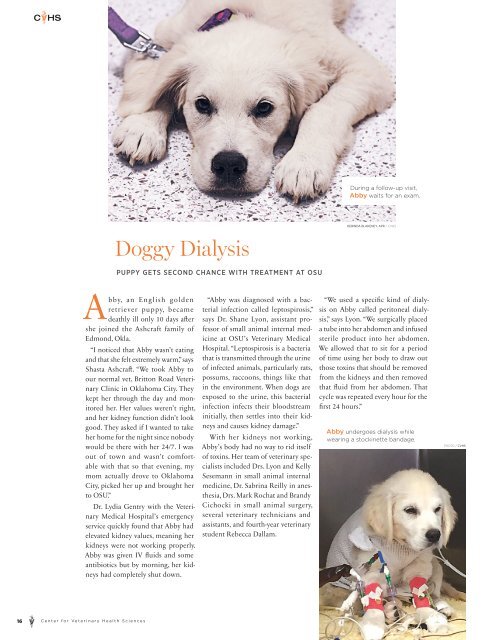Vet Cetera magazine 2015
Official magazine of the Center for Veterinary Health Sciences at Oklahoma State University
Official magazine of the Center for Veterinary Health Sciences at Oklahoma State University
Create successful ePaper yourself
Turn your PDF publications into a flip-book with our unique Google optimized e-Paper software.
During a follow-up visit,<br />
Abby waits for an exam.<br />
Doggy Dialysis<br />
DERINDA BLAKENEY, APR / CVHS<br />
PUPPY GETS SECOND CHANCE WITH TREATMENT AT OSU<br />
Abby, an English golden<br />
retriever puppy, became<br />
deathly ill only 10 days after<br />
she joined the Ashcraft family of<br />
Edmond, Okla.<br />
“I noticed that Abby wasn’t eating<br />
and that she felt extremely warm,” says<br />
Shasta Ashcraft. “We took Abby to<br />
our normal vet, Britton Road <strong>Vet</strong>erinary<br />
Clinic in Oklahoma City. They<br />
kept her through the day and monitored<br />
her. Her values weren’t right,<br />
and her kidney function didn’t look<br />
good. They asked if I wanted to take<br />
her home for the night since nobody<br />
would be there with her 24/7. I was<br />
out of town and wasn’t comfortable<br />
with that so that evening, my<br />
mom actually drove to Oklahoma<br />
City, picked her up and brought her<br />
to OSU.”<br />
Dr. Lydia Gentry with the <strong>Vet</strong>erinary<br />
Medical Hospital’s emergency<br />
service quickly found that Abby had<br />
elevated kidney values, meaning her<br />
kidneys were not working properly.<br />
Abby was given IV fluids and some<br />
antibiotics but by morning, her kidneys<br />
had completely shut down.<br />
“Abby was diagnosed with a bacterial<br />
infection called leptospirosis,”<br />
says Dr. Shane Lyon, assistant professor<br />
of small animal internal medicine<br />
at OSU’s <strong>Vet</strong>erinary Medical<br />
Hospital. “Leptospirosis is a bacteria<br />
that is transmitted through the urine<br />
of infected animals, particularly rats,<br />
possums, raccoons, things like that<br />
in the environment. When dogs are<br />
exposed to the urine, this bacterial<br />
infection infects their bloodstream<br />
initially, then settles into their kidneys<br />
and causes kidney damage.”<br />
With her kidneys not working,<br />
Abby’s body had no way to rid itself<br />
of toxins. Her team of veterinary specialists<br />
included Drs. Lyon and Kelly<br />
Sesemann in small animal internal<br />
medicine, Dr. Sabrina Reilly in anesthesia,<br />
Drs. Mark Rochat and Brandy<br />
Cichocki in small animal surgery,<br />
several veterinary technicians and<br />
assistants, and fourth-year veterinary<br />
student Rebecca Dallam.<br />
“We used a specific kind of dialysis<br />
on Abby called peritoneal dialysis,”<br />
says Lyon. “We surgically placed<br />
a tube into her abdomen and infused<br />
sterile product into her abdomen.<br />
We allowed that to sit for a period<br />
of time using her body to draw out<br />
those toxins that should be removed<br />
from the kidneys and then removed<br />
that fluid from her abdomen. That<br />
cycle was repeated every hour for the<br />
first 24 hours.”<br />
Abby undergoes dialysis while<br />
wearing a stockinette bandage.<br />
PHOTO / CVHS<br />
16 Center for <strong>Vet</strong>erinary Health Sciences


